Keyword: Mughal – Image Gallery

The divine messenger (Agnipurusha) rises from the sacrificial fire to bear vessel of celestial food by Nadim (1597- 1605)
from: The Ramayana
National Museum of Asian Art, Smithsonian Institution, Washington D.C.
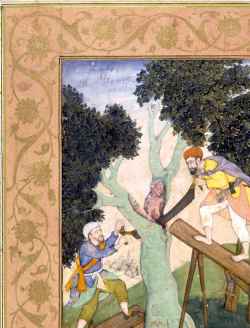
The martyrdom of the prophet Zakariya, who, taking refuge in a tree, was sawn in half by two men. (1605 - 1610)
from: This album of 104 folios known as the Clive Album
London, V&A Museum
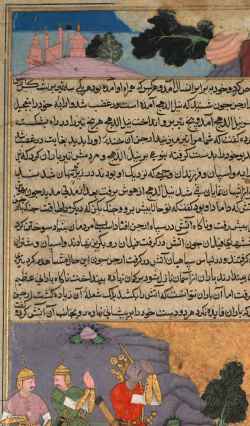
"The First Adventure of the White Horse". The king performed the horse sacrifice in order to determine the extent of his rule. For one year a horse wanders and every land through which the horse passes becomes part of the king’s territory. Arjuna following the horse encountered the son-in-law of the god of fire, Agni, who creates a river of fire to block the warriors. Arjuna pleads with Agni, the god of fire that the horse be allowed to pass, saying that the horse sacrifice is in accordance with sacred Vedic injunctions, and that at the end of the year, the horse will be sacrificed to him, the god of fire himself. (1610-1617)
from: Page from the Khan Khanan's Razm Nama (Book of Wars)
The Cleveland Museum of Art
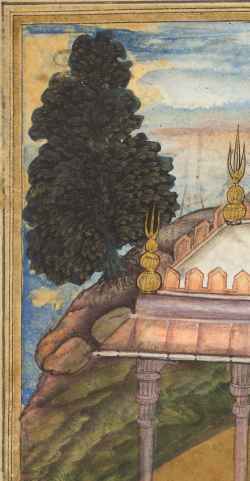
Yaja and Upayaja perform a sacrifice for the emergence of Dhrishtadyumna from the fire (1598)
from: from Adi-parva (volume one) of the Razm-nama (Book of Wars) adapted and translated into Persian by Mir Ghiyath al-Din Ali Qazvini, known as Naqib Khan (Persian, d. 1614) from the Sanskrit Mahabharata
The Cleveland Museum of Art

Valmiki instructs Kusha and Lava in the recitation of the "Ramayana" before the occasion of a sacrifice in Rama's palace (1597-1605)
from: The Ramayana (Tales of Rama; The Freer Ramayana), Volume 2
National Museum of Asian Art, Smithsonian Institution, Washington D.

Hanuman and the monkeys assault the demons, forcing Indrajita to break off the sacrifice that would make him invincible (1597-1605)
from: The Ramayana (Tales of Rama; The Freer Ramayana), Volume 2
National Museum of Asian Art, Smithsonian Institution, Washington D.C.
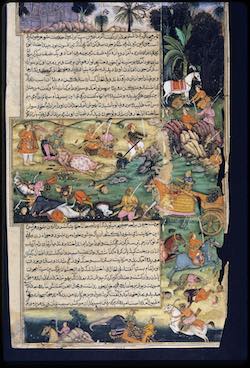
Satrughna is wounded by Kusa and Lava during Rama's horse-sacrifice (1616)
from: Leaf from a dispersed manuscript of Razmnama
Harvard University, Fine Arts Library, SS_22349926
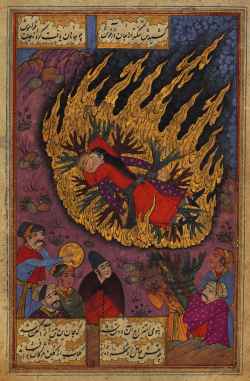
Satī, from a Sūz u Gudāz manuscript. The union of the couple on the pyre (1657)
from: Sūz u Gudāz ms, Iran, Walters Manuscript W. 649, fol. 19b (Burning and Melting)
The Walters Art Museum, Baltimore, Maryland
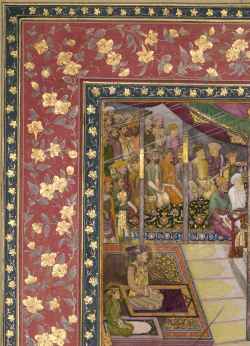
Emperor Jahangir and Prince Khurram at the gathering for the Feast of the Sacrifice (1615-1625)
from: India
Staatliche Museen zu Berlin, Museum für Islamische Kunst
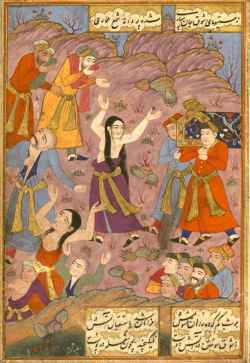
the young Hindu woman accompanies her bridegroom's coffin to the funeral pyre and decides to commit sati (1657)
from: Walters manuscript W.649 (Burning and Melting)
The Walters Art Museum
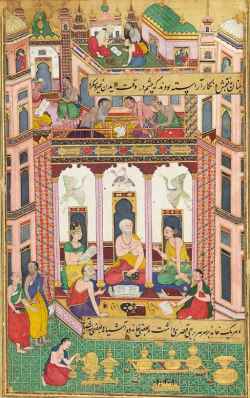
The building for King Dasaratha's sacrifice (Mughal India) (1594)
from: Miniature (35.4 x 21cm), fol. 27r
Christie's, London
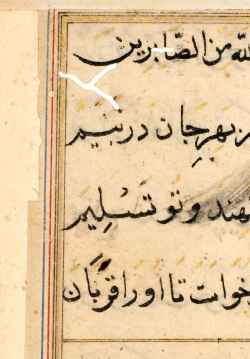
The sentinel in the employ of the Shah of Tabaristan prepares to sacrifice his son to the ghost of the Shah’s soul (Mughal India, court of Akbar) (1560)
from: from a Tuti-nama (Tales of a Parrot): Second Night
The Cleveland Museum of Art

A mountain city with multistoried hill architecture. Outside the gates on the right is a Saivite shrine with a lingum covered by floral offerings to which a goat is led, probably for sacrifice. (17th)
from: Unidentified Hindu chronicle of a King
Metropolitan Museum, New York
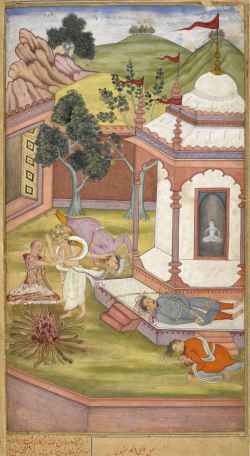
Candrahasa sacrifices himself cutting off pieces of his own flesh and putting them on the fire [1598]
from: Razmnāmah by Abhinanda, India (The last volume of the Persian translation of the Mahābhārata commissioned in 990 by Akbar)
London, British Library, Or 12076 folio: 90v
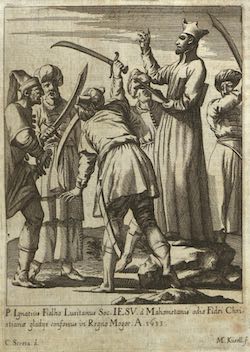
Ignatius Fialho, missionary in the Maghul empire, surrounded by Muslims woth swords (1675)
from: Tanner, Mathias, Societas Iesu usque ad sanguinis et vitae profusionem militans, Typis Universitatis Carolo-Ferdinandeae in Collegio Societatis Jesu ad S. Clementem, Prague 1675, p. 342
